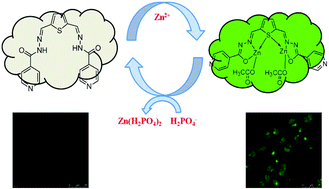A highly fluorescent zinc complex of a dipodal N-acyl hydrazone as a selective sensor for H2PO4− ions and application in living cells†
Abstract
A dipodal N-acyl hydrazone receptor (R1) was synthesized in a single step, and utilized as a test probe for the selective sensing of metal ions as well as anions. Upon the exposure to various metal ions, R1 displays rapid colorimetric and absorption changes in the presence of Co2+, Ni2+, Cu2+ and Zn2+ ions. However, R1 shows a selective fluorescence response only in the presence of Zn2+ ions and no other metal ions showed obvious changes. In particular, zinc acetate showed higher sensitivity over other zinc sources. Upon the binding of Zn2+ ions with R1, the colorless solution changed into fluorescent yellow color accompanied by the conversion of the non-fluorescence nature into the highly fluorescence nature. The in situ formed R1–Zn2+ complex was further explored for the reversible recognition of H2PO4− ions selectively over other anions such as F−, Cl−, Br−, AcO−, CN−, HSO4− and NO3− ions. A strong and enhanced emission at 502 nm and 534 nm corresponding to the R1–Zn2+ complex was quenched completely in the presence of H2PO4− ions. Relay recognition of different phosphates such as mono, di and tri basic phosphate ions was also tested. Furthermore, R1 has good cell permeability and could serve as a bioprobe in living cells for the intracellular uptake of Zn2+ and H2PO4− ions. Time dependent density functional (TDDFT) calculation has been performed to demonstrate the binding of Zn2+ ions with R1.



 Please wait while we load your content...
Please wait while we load your content...